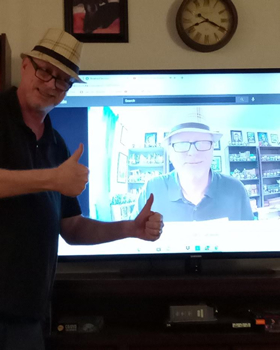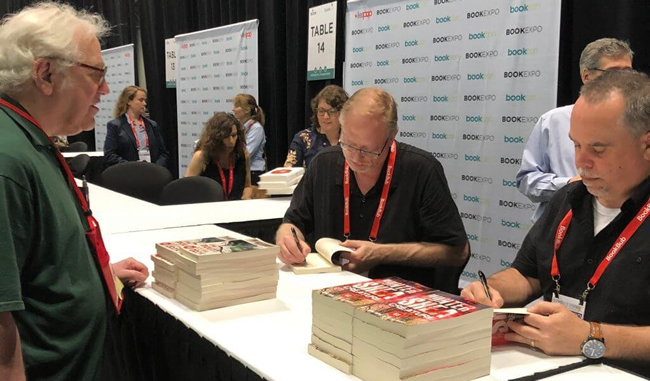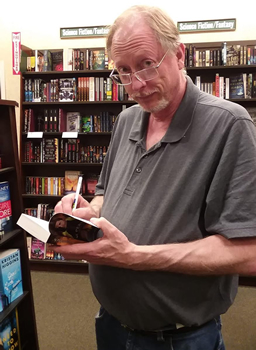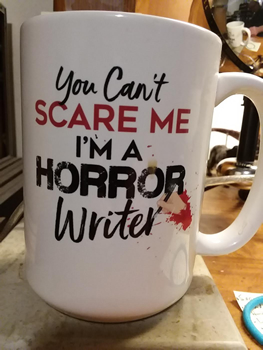

Up Close: Tim Waggoner
The Weird World of Movie Tie-ins
The practice of turning a movie into a novel has a surprisingly long history. The 1916 French crime melodrama Les Vampires was accompanied by a seven-volume novelization, and we’re fortunate enough to have two surviving novelizations of the lost 1927 Tod Browning film London After Midnight. The practice had its heyday in the 1970s and ’80s, with novelizations of popular genre franchises such as Star Wars and Alien selling millions of copies. There’s still a thriving market for movie tie-ins; in 2014, Greg Cox’s novelization of Godzilla hit the New York Times bestseller list.
If you think the novelization process is as simple as translating a screenplay into prose, think again. Turning a 90-page script into a 250-page novel requires some creative heavy lifting: Characters are fleshed out, story beats are expanded and rendered in vivid detail, and blanks are filled in. Sometimes there’s considerably more world-building, and questions that might have gone unanswered on screen must be addressed. It takes a skilled author with a keen sense of character and pace, and, in the case of a franchise, a deep knowledge of what’s come before, not to mention an understanding of what fans love about the property.
In other words, it takes an author like Tim Waggoner. Since his 2001 debut, Waggoner has published more than 50 novels, seven short story collections, and two books on writing. (A third is on its way.) He’s a three-time Bram Stoker Award winner, and in 2015 the Horror Writers Association named him its Mentor of the Year. He’s also one of the industry’s most prolific authors of movie, TV, and game tie-ins—a role that’s seen Waggoner make creative contributions to such franchises as Supernatural, A Nightmare on Elm Street, Resident Evil, and Grimm.
This month, Waggoner can add Halloween to that impressive list with his official movie novelization of HALLOWEEN KILLS. In his latest interview with The Big Thrill, Waggoner offers a fascinating, in-depth look at the process of writing a movie novelization, explains how he approached one of horror’s most iconic villains, and weighs in on the controversy about the new movie’s amped-up body count.
How did you first get into the movie tie-in field?
I’ve been writing media tie-in novels along with my original work for almost 20 years. I’d published several books detailing new adventures for the Winchester brothers from Supernatural for Titan Books, and one day an editor from Titan approached my agent and asked if I’d be interested in doing a novelization of Resident Evil: The Final Chapter. I’d seen all the movies in the Resident Evil franchise and enjoyed them, and I was excited to write the novelization, not just because it was Resident Evil, but because I’d never written a novelization before, and I was interested in learning what it was like.
Can you tell me about the process of writing a movie novelization? I assume you’re working from the script…
The script is all a novelization writer gets, and it may not be the final shooting script. But it’s what you have to work from. People assume novelization writers get to see the movie ahead of time, but you don’t. The director of Kingsman: The Golden Circle insisted I see the film before writing the novelization, and I was flown out to LA to see an advance screening, but that was an exception to the rule. Sometimes a studio might send you reference photos, but that’s never happened to me.
The first thing I do once I get a script is read it through once for the story, and then I go through it and look for areas that I can expand on. Scripts don’t contain enough material to fill an entire novel, so the writer needs to add material to the story. I also try to come up with some new scenes I can create that will work with the story, flesh it out more, deepen its concepts or themes, etc. Then I type all the dialogue into Word since I know I’m going to use it all, and then I write the rest of the book around the dialogue. Some scriptwriters are more descriptive than others, so I’ll use whatever details they provide, and what they don’t provide, I make up myself. While I write, I search the Internet for any production photos that may have been posted so I can use them for reference, and I look for any interviews with the writer, the director, and the actors that might give me any insight into the story.
Once I finish a draft, it goes to an editor. He or she will suggest changes and edits, and I make them. The manuscript is then sent to whoever at the studio is in charge of reviewing licensed work, and they suggest more changes. I make the revisions, and then the manuscript goes back to the editor and the studio. Usually they don’t have any changes at this point, and the manuscript is approved to go into production.
How did you become involved with HALLOWEEN KILLS?
An editor from Titan reached out to my agent to ask if I’d be interested in writing the novelization, and I was like, Hell yeah! I’d seen the original 1978 Halloween in the theater when it came out, and it was a thrill to get to write such an iconic horror character as Michael Myers.
When you first read the script, what were your first thoughts as a Halloween fan, and then as the writer tasked with stretching the script into a novel?

Waggoner wins a Bram Stoker Award for his book Writing in the Dark. (The ceremony was a virtual event.)
As a fan, I liked how the story explores the idea of the effect Michael has had on the town of Haddonfield and its residents over 40 years. That’s an area that slasher films rarely explore. There are also some flashbacks to events that take place in 1978, right after the original film, and I thought those scenes were fun. I also liked the fact that Laurie’s injuries from the previous film were taken seriously, and that—unlike Michael—she couldn’t just jump out of her hospital bed and go into battle.
As a writer, one of my main concerns was how to write scenes from Michael’s point of view. I read John Passarella’s novelization of the 2018 Halloween to see how he wrote Michael, and I also read Dennis Etchison’s novelization of Halloween II, which he wrote under the name of Jack Martin, to see how he did it. I’m a huge fan of Etchison’s work—so much so that I dedicated my novelization to him. Michael is a character who exists in a gray zone between the real and supernatural worlds, without it ever being made clear which he really belongs to. He’s an enigma, and I wanted to keep that aspect of the character in my novel.
How much creative leeway did you have?
I’ve never had a studio or editor spell out exactly how much leeway I have with a novelization, so I just feel it out as I go. I know I can flesh out existing scenes and write more internalization for characters—more of their thoughts, feelings, and reactions than are in the script. I’ll also add details here and there that reveal more about the characters or the setting. For example, I wrote a couple paragraphs in HALLOWEEN KILLS talking about what happened to Michael’s parents after the 1978 movie. When it comes to adding brand-new scenes—stuff I make up entirely—I’m careful to build upon the story as it exists. I try not to add anything that will bend or break the rules of the world that the scriptwriters have set up. For example, I’d never write a scene that has Michael speaking. And I’d never write one that depicts him as heroic or showing mercy. So far, I’ve never had a studio representative tell me that I had to delete anything that I’ve added to a novelization, and that was the case with HALLOWEEN KILLS as well.
How involved were the filmmakers/Blumhouse?
Most of the time, you don’t know who exactly at the studio is reviewing your manuscript. I found out that Ryan Turek and some others at Blumhouse read my novelization only because Ryan mentioned it in an interview. The feedback I got from the studio came without any attribution, so I don’t know who—or how many people—provided it.
How much of the dialogue from the script did you keep?
All of it. Normally I’ll change or adapt dialogue as needed for a novelization. For example, a script might have a line of dialogue like this: “No, no, no!” An actor can invest each of those no’s with a different emotion, but I can’t replicate that effect on the page, so I might shorten the line to a single no. I did this in HALLOWEEN KILLS, but the studio insisted I use every line of dialogue for the movie exactly as written in the script, so I did. It was the only thing that the folks at Blumhouse insisted on.
The scenes from Michael’s POV are such a balancing act—the nature of the character really keeps you from going too deep. How did you approach those scenes?
I tried to write them from a more removed narrator’s voice, so readers were never given full access to Michael’s thoughts (assuming he has any). I wrote them with Michael always having a sharp focus on his current goal (which was always to kill someone), and focused on stimulus and response. I wrote him in many ways like I might write a shark. Sharks are predators who are what they do. They don’t think—they act and react. These were my favorite scenes to write, and I hope readers think I did a good job.
Some viewers have been put off by the new movie’s graphic gore and high body count. What are your thoughts?
On one level, I think it takes away something from Michael’s original portrayal as a lurker and stalker, a being that moves in and out of shadow, and who seems to specifically target certain victims for his own unknown reasons rather than killing indiscriminately. But on another level, if you’re going to explore the theme of violence and what that can do to a community long term, you need to show that violence and its effects. In this timeline, Michael has been institutionalized for 40 years since his killings in 1978, so he probably has a lot of pent-up aggression to get out! In the book, I tried to portray the increase in violence as part of Michael’s evolution. He killed one person—his sister—in 1963, then he killed a handful of people in 1978, and in 2018, he kills many people. Each time he returns to Haddonfield, he becomes a more evolved and deadly predator.
The franchise has been pretty ambiguous about Michael’s nature. Was it hard for you to maintain that sense of mystery as to whether or not he’s human?
It was a balancing act for sure. For example, in one of the earliest scenes, Michael escapes from a house fire. I had to find a way to make this seem logically possible to preserve the idea that Michael might be human—an extraordinary human, but a human nevertheless. I had to do a lot of research on exactly what happens when a house catches fire and burns down, and what it would take to survive. Other times, I wrote Michael as if he was an inhuman wraith to preserve the sense that he might be a supernatural entity of some sort. I’d do this by presenting Michael through other characters’ perceptions. Michael appears inhuman to them, but the story doesn’t implicitly state that he is inhuman. Hopefully, I got the balance right!
What can you tell us about what’s next for you?
I’ll have a tie-in novel called Planet Havoc, set in the world of the Zombicide: Invader game, out in April. My next original horror novel, We Will Rise, comes out in July. It’s about a ghost apocalypse—ghosts appear across the world and begin attacking and killing people. And my follow-up to my how-to-write horror book, Writing in the Dark, will be out sometime in 2022. It’s the Writing in the Dark Workbook, and it’s filled with exercises and craft tips to help you take your horror writing to the next level.
- Africa Scene: Iris Mwanza by Michael Sears - December 16, 2024
- Late Checkout by Alan Orloff (VIDEO) - December 11, 2024
- Jack Stewart with Millie Naylor Hast (VIDEO) - December 11, 2024






